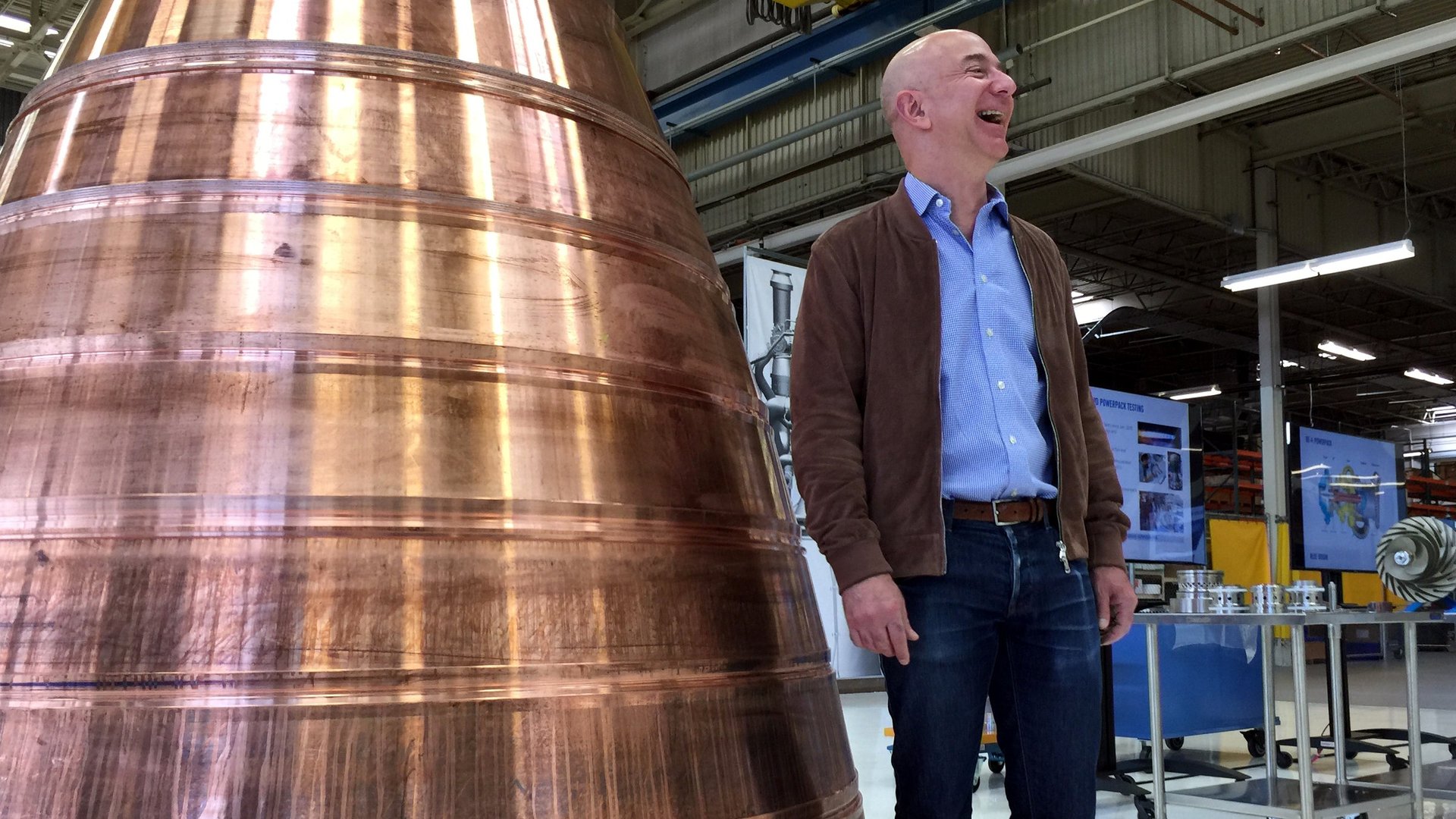Jeff Bezos says he’s putting billions into space. He’s not alone
Jeff Bezos said last week he is cashing out one billion dollars of Amazon stock every year to finance his space company, Blue Origin, which aims to fly tourists to the edge of space next year.


Jeff Bezos said last week he is cashing out one billion dollars of Amazon stock every year to finance his space company, Blue Origin, which aims to fly tourists to the edge of space next year.
Blue Origin refused to confirm Bezos’ investments or how long he has been putting up such a sum, though SEC filings show that Bezos sold two million Amazon shares in 2016 for more than $1.4 billion.
But whatever amount Bezos has put into Blue Origin, he’s certainly not the only tech investor looking to space—since 2002, when Blue Origin rival SpaceX was founded by Elon Musk, venture investment in the sector has increased markedly, according to analysis provided by the data firm Preqin. That year saw five deals investing $26 million. Last year, 61 deals put $462 million into space start-ups, and investors are well on pace to beat those numbers this year through 3/21.
Space businesses have traditionally been predicated on heavily regulated government contracts, with deeply entrenched industry giants taking the biggest share of the work. But in the last decade, a number of trends have made extra-terrestrial business plans more attractive to nimble entrepreneurs seeking quick returns.
Moore’s law in space
“About five years ago, 2012 was our first foray into space with [satellite imaging company] SkyBox,” Deepak Kamra, a partner at the venture fund Canaan Partners, tells Quartz. “The only other big visible one out there was SpaceX. I think VCs, what caused it to take off, people see that SkyBox got an exit valuation of $500 million [when being acquired by Google in 2014.] A lot of it is seeing that there is a venture business here that doesn’t take billions of dollars of capital.”
Skybox didn’t take a lot of capital because cheaper, smaller components allowed it to rely on small satellites, roughly the size of a shoebox, rather than much heavier and more expensive ones. That’s important in a business where the cost of putting equipment in space is typically measured in tens of thousands of dollars per kilogram.
“Now you can build a spaceship cheaply, that means that venture capitalists can play,” Kamra says, noting a number of start-ups also trying to build low-cost small rockets. “People were intimidated by the fact that you needed giant rockets.”
Canaan Partners, for example, is an investor in another satellite company, Capella Space, that will use radar to see through clouds. It is one of several new satellite companies, and accompanying plays to crunch the data they produce, that are attracting VC attention.
“The important portion of the increase (and a key part of the trend) is from people that believe, like us, that Moore’s Law has come to space,” Matt Ocko, a partner at venture fund Data Collective, writes in an e-mail, adding that “micro/nanosats able to deliver the functionality of ‘mainframe’ sats in turn enable reduced launch costs, larger constellations, faster time to return, lower aggregate risk.”
Data Collective, which is the lead investor Capella Space, also backs Planet, a satellite firm that recently acquired Skybox from Google and now operates the most satellites of any private company, and Rocket Labs, a firm building rockets to launch small satellites. Data Collective led a $75 million investment in Rocket Labs this year that valued it at $1 billion, making it the rare “space unicorn.”
Private pioneers
Almost all observers point to another space unicorn, SpaceX, as a key reason the sector is attracting more attention. It has spurred a race to cut space-access costs across the industry, further reducing the capital burden on new space companies.
Musk’s firm showed that a start-up could compete with major space players on their own terms, while driving down cost with Silicon Valley-style management. Now valued at more than $11.5 billion, the company hit a major milestone in March by flying the first-ever reusable orbital rocket booster—which promises even deeper cost reductions.
“Until recently, a big bottleneck for commercial space was simply launch capacity,” says Scott Nolan, a partner at Founder’s Fund, an early investor in the company. “SpaceX’s now proven reusability will dramatically reduce launch costs and meaningfully increase both global launch capacity and frequency. We believe this shift will enable new businesses across a number of applications, and in the process unleash the next wave of space investors.”
Like Bezos, Musk funded SpaceX himself, using earnings from the sale of PayPal to eBay. During the company’s first six years, he put in $100 million. Even then, it required an $20-million capital infusion from Founder’s Fund, run by Musk’s former colleague Peter Thiel, in 2008, before the first rocket was successfully launched. SpaceX also raised money with NASA contracts and deposits from future customers. In 2013, company president Gwynne Shotwell estimated the company had spent $850 million developing its flagship rocket to fly missions for the US space agency, mostly raised from private sources over 11 years.
Compare that to SpaceX’s most recent fundraising round, a $1-billion investment that makes 2015 an outlier in the chart above, which was co-led by Google and the mutual fund purveyor, Fidelity Investments.
That’s a sign that conventional wisdom is changing. Ocko, the investor at Data Collective, points to “VC cargo-cultism” to explain some of the growth in the sector–”Hey, SpaceX and Planet Labs are big wins, so let’s throw some money at anything that looks similar.”